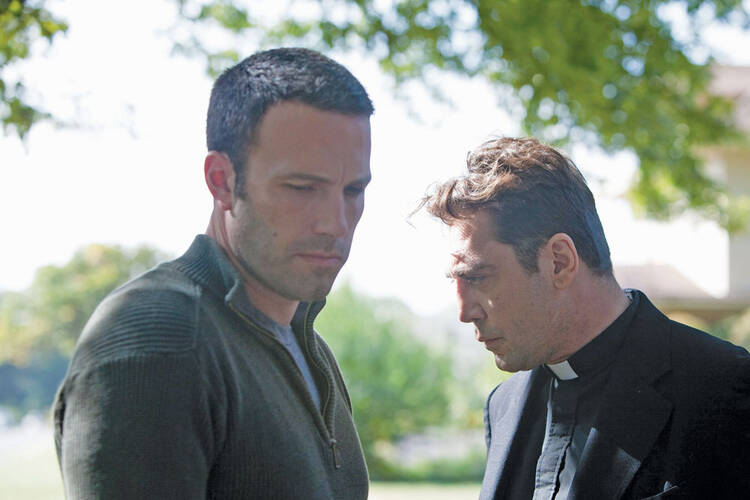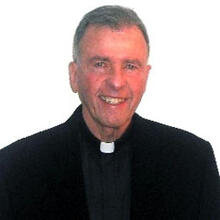If during a visit to a movie theater, you have been exposed to eight or 10 trailers depicting crashing automobiles, huge explosions and an almost deafening soundtrack—a phenomenon perhaps suggesting that films are getting dumber and dumber, despite better and better technology—then you may welcome Terrence Malick’s To the Wonder as a kind of cinematic parousia. Malick’s film, almost as visually beautiful as his “The Tree of Life,” from which he borrows some footage, is a demanding but ultimately richly rewarding film.
The narrative centers on four characters: Neil (Ben Affleck), Marina (Olga Kurylenko), Father Quintana (Javier Bardem) and Jane (Rachel McAdams), each at different stages of alienation in a world from which God seems absent. The film opens with a blurry image from a cell phone camera, a foreshadowing of its characters’ difficulty in communicating with one another and with God and perhaps also acting as an invitation or even a warning from Malick that we should pay avid attention to the images he will put before us and trust our reactions to them.
At the beginning of “To the Wonder,” Neil and Marina are lovers in France and their love reaches its peak, at least for Marina, when they visit Mont Saint-Michel in Normandy, site of the Benedictine abbey. Malick makes a point of pausing his camera on the baptismal font. Marina wonders about the love that surrounds them, the love that loves them, that seems to come from nowhere. She describes climbing the steps to the island’s highest peak as climbing “to the wonder.”
When Neil takes Marina back with him to Oklahoma, their relationship becomes strained. Malick shows us several scenes of them engaging in passionate sexual encounters; but when their relationship demands a deeper commitment, Neil behaves like one of T. S. Eliot’s “hollow men,” lacking substance beneath the surface. He has an affair with Jane, a childhood sweetheart and now a divorcée struggling to find herself. Marina seeks advice from Father Quintana, who believes in Christ’s presence in his life but is going through a dry spell, perhaps even a dark night of the soul.
In “To the Wonder” there are numerous shots of windows, but for much of the film the characters’ vision seems stunted. There are numerous shots of open doors, yet the characters remain confused about the direction their lives should take.
There are moments in Malick’s film that may call to mind the work of other important directors. In depicting the absence of God, Malick steps into the territory of Ingmar Bergman and Woody Allen. In depicting the ultimate success of Marina and Father Quintana in experiencing God’s presence, Malick’s work resembles to some extent that of Carl Dreyer and Robert Bresson, whom the author and director Paul Schrader described in his book Transcendental Style as having developed a style that successfully presented the transcendent. At times in “To the Wonder” Marina seems like one of the director Michelangelo Antonioni’s lost souls; but unlike Antonioni, Malick never embraces nihilism. The “nothingness” that interests Malick is the supraconceptual experience of God that mystics report.
But whatever resemblances Malick’s work has to that of other directors, his wedding of message and method is unique. No one else is making films like Malick’s, and I suspect in the history of movies no one ever has. “To the Wonder” is visually gorgeous and aurally marvelous, with a soundtrack that includes music by Wagner, Haydn, Berlioz and Tchaikovsky.
While watching “To the Wonder,” we might feel that we are being bombarded by beautiful images. Rather, we are being seduced by them to turn toward the Beauty that is the source of nature’s beauty. The description of Malick as a “naturalist” is accurate if the term means that he is in awe of nature’s beauty and presents it magnificently in his movies. It is inadequate if it suggests rejection of the supernatural or that which transcends nature.
“To the Wonder” shares the preoccupations displayed in “The Tree of Life,” and both display Malick’s brilliant use of stunning images and beautiful music. At the risk of oversimplifying the similarity and the dissimilarity of the two films, I suggest that with “The Tree of Life” Malick presented a Teilhardian evolutionary vision, starting with the big bang more than 13 billion years ago, leading down to the interpersonal relationships in a Catholic family. The evolutionary movement culminated with a surreal depiction of the resurrection of Jesus and of love relationships beyond the grave. In “To the Wonder” Malick starts with the experience of human beings trying to love and then ascends to God.
Malick’s preoccupation with the divine is most obvious in the characters of Father Quintana and Marina. Like the other three actors, Rachel Adams turns in a fine performance, but her character, Jane, does not have enough screen time or undergo enough development for us to guess if she will work out her problems. Neil, who announces at one point “I have no faith,” seems permanently adrift. Father Quintana’s parishioners sense his problem. An old woman says to him, “Father, I’m going to pray for you, so you receive the gift of joy.” In Quintana’s church, a man cleaning a window, significantly a stained glass window, urges the priest to go out into the world and feel the power of God. Father Quintana does just that.
One of the most striking scenes in the film is of Father Quintana exercising his ministry in a prison, distributing Communion to prisoners through a small opening in the cell wall. They are physically imprisoned, and he had been spiritually imprisoned. There is a wonderful montage of Father Quintana serving others as a priest, each shot accompanied by a voiceover of Father Quintana reciting a line from the prayer of St. Patrick:
Christ with me, Christ before me,
Christ beneath me, Christ above
me,
Christ at my right, Christ at my
left.
Early in the film, Marina wonders about the love that loves us and surrounds us. At the end, she again refers to the love that loves us, this time saying only, “Thank you.” At that point I wanted to say, “Thank you” to Malick.
Have no doubt that this is a demanding film. I cannot imagine it being a big commercial success. Supposedly Ben Affleck said, after viewing the film, that “To the Wonder” made “The Tree of Life” look like “Transformers.” In the lobby of one New York multiplex theater in which “The Tree of Life” was playing there was a sign that read, “If you go to see ‘The Tree of Life,’ don’t ask for your money back.” I can imagine that theater putting up a similar sign for “To the Wonder.” In my opinion, however, it is money well spent.








